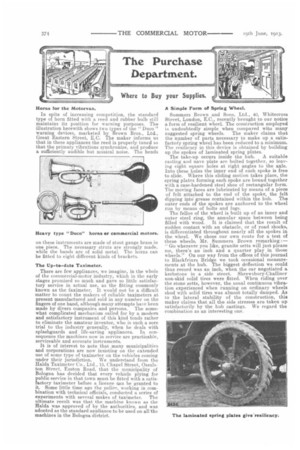Horns for the Motorvan.
Page 26

If you've noticed an error in this article please click here to report it so we can fix it.
In spite of increasing competition, the standard type of horn fitted with a reed and rubber bulb still maintains its position for warning purposes. The illustration herewith shows two types of the " Duco " warning devices, marketed by Brown Bros., Ltd., Great Eastern Street, E.C. The maker informs us that in these appliances the reed is properly tuned so that the primary vibrations synchronize, and produce a sufficiently audible but musical noise. The bends on these instruments are made of stout gauge brass in one piece. The necessary struts are strongly made, while the bands are of solid metal. The horns can be fitted to eight different kinds of brackets.
The Up-to-date Taximeter.
There are few appliances, we imagine, in the whole of the commercial-motor industry, which in the early stages promised so much and gave so little satisfactory service in actual use, as the fitting commonly known as the faximeter. It would not be a difficult matter to count the makers of reliable taximeters at present manufactured and sold in any number on the fingers of one hand, although many attempts have been made by divers companies and persons. The somewhat complicated mechanism called for by a modern and satisfactory instrument of this kind tends rather to eliminate the amateur inventor, who is such a sore trial to the industry generally, when he deals with splashguards and . life-saving appliances. In. consequence the machines now in service are practicable, serviceable and accurate instruments.
It is of interest to note that many municipalities and corporations are now insisting on the extended use of some type of taximeter on the vehicles coming under their jurisdiction. We understand from the Halda Taximeter Co.. Ltd., 15, Chapel Street, Ossulston Street, Euston Road, that the municipality of Bologna has decided that every vehicle plying for public service in that town must be fitted with a, satisfactory ta.ximeter before a licence e,an be granted to it. Some little time ago the police, working in combination with technical officials, conducted a series of experiments with several makes of taximeter. The ultimate result was that the machine known as the Halda was approved of by the authorities, and was adopted as the standard appliance to be used on all the machines in the Bologna district.
A Simple Form of Spring Wheel.
Summers Brown and Sons, Ltd., 40, Whitecross Street, London, E.C., recently brought to our notice a form of resilient wheel. The construction employed is undoubtedly simple when compared witu many suggested spring wheels. The maker claims that the number of parts necessary to make up a satisfactory spring wheel has been reduced to a minimum. The resiliency in this device is obtained by building up the spokes of laminated spring plates.
The take-up occurs inside the hub. A suitable casting and nave plate are bolted together, so leaving eight square holes at right angles to the axle. Into these holes the inner end of each spoke is free to slide. Where this sliding motion takes place, the spring plates forming each spoke are bound together with a case-hardened steel shoe of rectangular form. The moving faces are lubricated by means of a piece of felt attached to the end of the spoke, the felt dipping into grease contained within the hub. The outer ends of the spokes are anchored to the wheel rim by means of bolts and lugs. The felloe of the wheel is built up of an inner and outer steel ring, the annular space between being filled with wood. It is claimed that the result of sudden contact with an obstacle, or of road shocks, is differentiated throughout nearly all the spokes in the wheel. We chose our own route for a test of these wheels, Mr. Summers Brown remarking :— "Go wherever you like, granite setts will just please me, there's an inch and a quarter play in those wheels." On our way from the offices of this journal to Blackfria.rs Bridge we took occasional measurements at the hub. The biggest deflection we could thus record was an inch, when the ear negotiated a. kerbstone in a side street. Shrewsbury-Challiner non-skid solid tires were fitted. When riding over the stone Aetts, however, the usual continuous vibration experienced when running on ordinary wheels shod with solid tires was almost totally damped. As to the lateral stability of the construction, this maker claims that all the side stresses are taken up satisfactorily, by the hub castings. We regard the combination as an interesting one.




























